Episode 2 –
mid January 2018
Well there’s no going back
now, the new season is well and truly underway and from now on things
will just get busier and busier. We managed to get away for a quick
holiday a couple of weeks ago, so I’ve had to play catch up for a few
days since we got back home.
The old tubers that I
started off in early January are showing of plenty signs of life – see
below left and all but the biggest of my cutting tubers are now in the
propagators in the same 5 parts to 1 M2 and Vermiculite mix that I used
for starting all my tubers – see below centre and right.
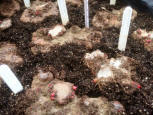
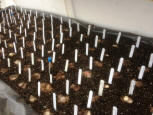
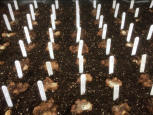
Cutting tuber harvest is a
bit of an apprehensive time for me; my success rate in terms of
producing a good quality tuber has been mixed and I struggle to
understand why. Don’t get me wrong, overall they are improving,
especially in terms of tuber size with the majority around 2 inches –
see Bali Hi and Nichola Coates below left - and a decent
amount close to 3 inches – see Joyce Mihulka below right but
there are areas for improvement. To be more specific, it is the plants
that retain their stems long after the others have fell off and then
when harvested they have virtually no tuber to speak of. I had a bad
time with this problem a couple of years ago and ‘hung my hat’ on the
theory that the rooted cuttings had been potted up too deeply and since
then I have been careful to ensure that they are not buried. Even so, I
have still had too many plants this year that have displayed this
problem.
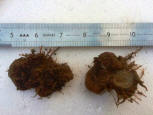
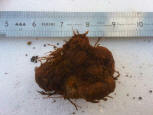
It’s worth saying that
certain varieties are much worse than others – Symestar seems to
be by far the worst under my conditions but thankfully it throws a lot
of cuttings and I take full advantage and root at least twice as many of
this variety than I need just because of this problem. I have recently
acquired Burnout and I managed to get a decent number of cuttings
from it but just as well because again too many of them have not
produced a viable tuber – see below. To be fair, it is worth pointing
out that with this variety, quite a few of my plants were from stem
cuttings, so that may be a contributing factor. Surprisingly, Tom
Brownlee has been affected by this problem and considering I haven’t
had this issue with it before and that these plants were rooted from
late March to early April I cannot understand why. It’s even more
puzzling why seemingly identical plants throughout the season are then
found to behave so differently at the end of the season, with one plant
retaining it’s stem but no tuber and the other loosing It’s stem on time
and producing a decent sized tuber. This anomaly continues but to a much
lesser extent when looking at the remaining varieties in my collection.
This year, rather than dumping these ‘tubers’ I am going to try starting
them up and will see how it goes. I may just get a cutting or two and
they may go on to produce a decent enough tuber for next years’ early
cuttings or they may be vigorous enough to produce a plant to flower
later in August – I’ll give it a go and see what happens – at the back
of my mind though is the risk that keeping plants that have this fault
should be avoided.

Well with the cutting tubers
I have, everything seems to be progressing well. I don’t give them the
bleach treatment like the older tubers get, they just come out of their
pots and straight into the propagator as soon as they have had a close
inspection for signs of rot, pests, diseases and scab issues. Any that
need minor surgery are left for a couple of days for wounds to heal
before they go in otherwise there will be an increased risk of grey
mould -
Botrytis
Cinerea – see below,
but I do not keep them in the warmth of the house as the smaller ones
especially would rapidly dehydrate. Also like the adult tubers I have
found virtually no evidence of vine weevils, just a handful of tubers
with some very small holes that have healed completely so I will
definitely be using the nematodes to treat this pest in future.

It
was a big relief when the Scottish Begonia Society Committee managed to
transfer some of the classes from the defunct Ayr show to Dundee at such
short notice, however the later date of Dundee has brought with it a new
challenge for growers who want to exhibit at both shows. In previous
seasons, the National and SBS show were only one week apart but now
there is a three week gap, which creates some additional timing issues.
When
these shows were just a week apart, later blooms for the first show
could hang on until the second one and early blooms for the second show
could be just about ready for the first show, but at three weeks apart
none of the blooms are transferrable. Now I honestly don’t think that
this is an big issue, it’s just a new challenge that we should all
embrace because once resolved, it will mean we have learned something
new and that should make us better growers. Besides, it extends the main
part of the flowering season and gives a longer break between two big
journeys and make blooms available for any shows in between. Also,
theoretically at least, the later date of Dundee should mean cooler
conditions for the critical last week before the show.
Another aspect of this gap between the shows concerns the date we start
up our tubers. Last season, I know that I wasn’t the only exhibitor who
thought that some of their Dundee plants felt like they had been growing
for too long by the time that they flowered, if that makes sense?
For a start, mine went into their final pots at the same time as my
Shrewsbury plants and as a result had probably used up most of the
fertilizer by around three weeks ahead of their bud securing dates for
Dundee so I had to resort to supplementary feeds.
They
also flowered, in some cases on the eighth bud and beyond which I don’t
like. In other words, the Dundee adult tubers were started up too early.
Additionally, the root systems would have been starting to become dense
at the time of bud securing, rather than still growing as they would
have been three weeks earlier, so I now have to weigh up the benefits of
starting them up in Late February / early March against the risk of the
tubers remaining in storage for longer, as opposed to my normal start up
date of between 10th and 15th February.
So
currently when I give my adult tubers their weekly health check, I am
gradually separating them into two batches – one to go in at my normal
date around mid February and a second for the end of February. Criteria
that I am using are:
● Varieties
– last season I used one of my two 16 x 8 greenhouses for Shrewsbury and
the other one for Dundee. Each greenhouse holds around 84 plants in 3
rows of 14 each side (I’d love to give them more elbow room but so far
it’s been a compromise between space and numbers that works) and I will
be doing the same this year, but I would like to have similar numbers of
the same varieties for each show. I know this won’t be 100% achievable
but I am aiming for approaching 90%. The remainder of the 200 plants I
am hoping to grow will be housed in my 10 x 8 Alton once the main
propagation phase is completed. Which varieties these plants will be
will depend on what is available but some of them will be the seedlings
that I retained for further trials from last years sowing of seed kindly
given by Michael Richardson – the cross is Powder Puff and Tom
Brownlee.
● Stage of growth
– those that are well pipped will be used for the first batch whenever
possible.
● Tuber condition – just some simple common
sense so that I use the ones that look like they will last better for
the second batch.
I am not staggering the
cutting tubers as mine tend to be a bit more erratic in pipping compared
to the adult tubers so they tend to sort themselves into early and late
season plants, however I have held a few of the bigger ones back to
start in mid February with the first batch of adults.
What’s keeping me awake at night?
Compost ingredients – I’ve made a good start on stocking up and hope to
have everything in place well before the main batch of adult tubers go
in, but until I have everything on site, I will be worrying whether:
●
All of my preferred products will be available?
● Will they be
physically the same as in previous years?·
● Will they be
fresh?
● Should I make
any adjustments?
● Should I try
any experiments?
● Will I be able
to borrow my wife’s accurate digital kitchen scales again to weigh out
my fertilizers without getting caught……?
Next episode – adult tuber preparation and start up.